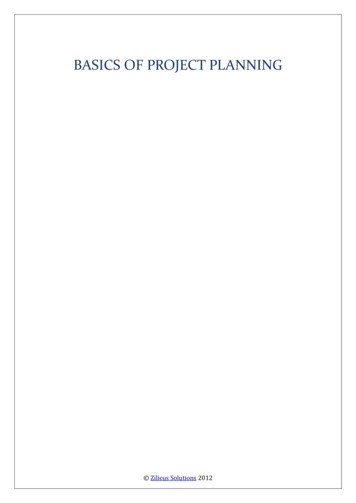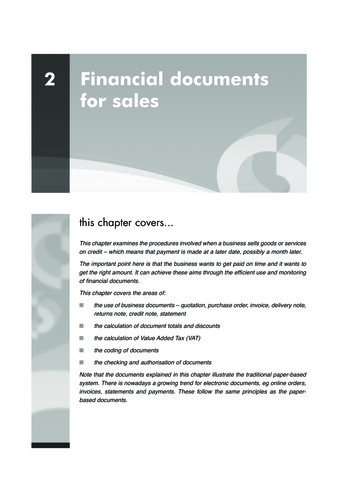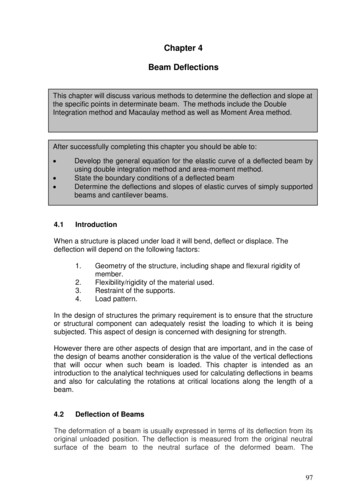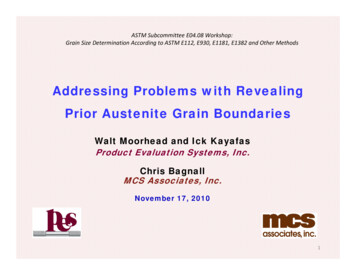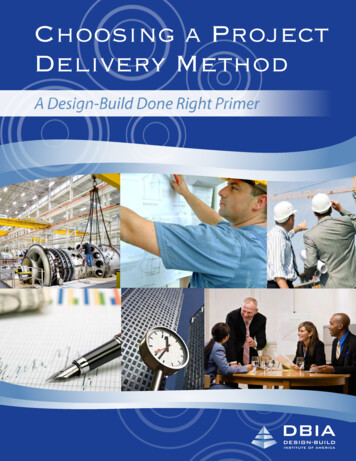
Transcription
Choosing a ProjectDelivery MethodA Design-Build Done Right PrimerDESIGN-BUILD DONE RIGHT PRIMER 1April 2015
Choosing a Project Delivery MethodA DESIGN-BUILD DONE RIGHT PRIMERA DESIGN-BUILD INSTITUTE OF AMERICA PUBLICATIONProject Delivery is a comprehensive process including planning, design and constructionrequired to execute and complete a building facility or other type of project. Choosing a projectdelivery method is one of the fundamental decisions owners make while developing theiracquisition strategy.WhatProcurementMethod?WhatContract Format?Procurement MethodsContract FormatsWhat ProjectDelivery System?Project Delivery SystemsConstruction Management at Risk(CMR) also known as CM/GCDesign-Bid-Build (DBB)Design-Build (DB)Multi-Prime (MP)Best Value (BVS)Cost Plus FeeLow BidGuaranteed Maximum Price (GMP)NegotiatedLump Sum (or Fixed Price)Qualifications-Based (QBS)Target PriceSole Source (or Direct Select)Unit PriceItems listed in alphabetical order.It is important for the owner to consider all three of these areas – and the options within each – when choosing the project delivery method.This primer focuses on the project delivery method selection.Determining the project delivery method is one of the most important decisions made by every owner embarking on a construction project.Choosing the best method for any project must start with a good understanding of choices available. Owners must also have a firm grasp ofthe impact of each choice, because the delivery method establishes when parties become engaged; it influences the choices of contractualrelationships; and it influences ownership and impact of changes and modification of project costs. In all delivery systems, there is always aminimum of three parties involved: owner, designer and contractor. It is important to choose a delivery method that best meets the uniqueneeds of each owner and their project.Project considerations have fundamental impacts on the delivery method selected. These considerations include a realistic budget, a schedulethat includes a reasonable performance period, a responsive and quality design process, a risk assessment with allocation of risks to theappropriate parties and a recognition of the level of expertise within the owner’s organization.Commonly Used Project Delivery Methods 1:Construction Management at Risk (CMR)2Design-Bid-Build (DBB) or traditionalDesign-Build (DB)Multi-Prime (MP)An owner has several areas of concern when embarking on a project. The chosen project delivery method may be a combination or hybrid ofmultiple delivery methods. Each of these delivery methods establishes different relationships among the parties involved and, subsequently,different levels or risk.1 Not included here is “Integrated Project Delivery” or “IPD” which refers to a contractual model where the owner, constructor, designer and potentially othersenter into a single, multi-party contract. The contract forms currently available anticipate that the owner, constructor and designer will enter into the same agreement,share some of the risks and rewards of the contract and potentially limit the liability among the parties. Due to the limited history of IPD, it is not included in this list ofcommonly used project delivery systems. 2 Construction Management as Agent (Agency CM) is not a project delivery method. It is a service that the owner may utilize tohelp with management of the project delivery methods such as multi-prime or design-bid-build.2 DESIGN-BUILD DONE RIGHT PRIMERApril 2015
Delivery Methods DefinedConstruction Management at Risk (CMR) (alsocalled CM at-Risk or CM/GC) – This delivery method entailsa commitment by the CMR for construction performance to deliver theproject within a defined schedule and price, either a fixed lump sum or aguaranteed maximum price (GMP). The CMR provides construction inputto the owner during the design phases and becomes the general contractorduring the construction phase.Design-Bid-Build (DBB) – The traditional U.S. project deliverymethod typically involves three sequential project phases: The designphase, which requires the services of a designer who will be the “designerof record” for the project; the bid phase, when a contractor is selected;and a build or construction phase, when the project is built by theselected (typically low bid) contractor. This sequence usually leads to asealed bid, fixed-price contract.Design-Build (DB) – This method of project deliveryincludes one entity (design-builder) and a single contract withthe owner to provide both architectural/engineering design servicesand construction.Design-Build EntityStructural AgreementsOwner5%28%13%Integrated Design-Builder FirmContractor LedDesigner (A/E) -Led54%Joint VentureSource: Zweig WhiteMulti-Prime (MP) – Although similar to design-bid-build relativeto the three sequential project phases, with MP the owner contractsdirectly with separate specialty contractors for specific and designatedelements of the work, rather than with a single general or primecontractor.DESIGN-BUILD DONE RIGHT PRIMER 3April 2015
key considerations when choosingdelivery methods:Construction Management at Risk (CMR) Three linear phases: design, bid, build or may be fast tracked.Three prime players: owner, designer and CM-constructor.Two separate contracts: owner to CM-constructor and owner to designer.Owner warrants the sufficiency of the plans and specs to the CM-Constructor: Owner is responsible for the “details” of design. Owner is liable for any “gaps” between the plans and specs and the owner’s requirements for performance.Key Considerations: Designer works directly for owner. The owner gains the benefit of having the opportunity to incorporate a contractor’s perspective and input to planning anddesign decisions: More professional relationship with contractor. Earlier knowledge of costs. Earlier involvement of constructor expertise. Project delivery typically faster than traditional design-bid-build. A primary disadvantage in CMR delivery involves the lack of direct contractual relationship between the contractor anddesigner, placing the owner between those entities for the resolution of project issues: Disagreements regarding construction quality, the completeness of the design, and impacts to schedule and budgetmay arise. As with the design-bid-build system, adversarial relationships may result.Design-Bid-Build (DBB) Three linear phases: design, bid and build.Three prime players: owner, designer and contractor.Two separate contracts: owner to designer and owner to contractor.Owner warrants the sufficiency of the plans and specs to the contractor: The contractor is responsible to build the project as designed. The designer is responsible to design to the professional standard of care. Owner is responsible for any “gaps” between the plans and specs and the owner’s requirements for performance.Key Considerations: This method is widely applicable, well understood, and has well-established and clearly defined roles for the parties involved. This method is presently a very common approach for public owners due to procurement statutes under which they operate. The owner has a significant amount of responsibility for the success or failure of the end product, particularly since the facility’sfeatures are fully determined and specified prior to selection of the contractor (Owner “owns” the details of the design). The contractor works directly for the owner. The designer works directly for the owner. Process may have a longer duration when compared to other delivery methods since all design work must be completed prior tosolicitation of the construction bids. Construction may not begin until the design and procurement phases are complete. The absence of construction input into the project design may limit the effectiveness and constructability of the design.Important design decisions affecting the types of materials specified and the means and methods of construction may be madewithout appropriate consideration from a construction perspective. There is no contractual relationship between the contractor and the designer. There is no opportunity for collaboration during the design phase.4 DESIGN-BUILD DONE RIGHT PRIMERApril 2015
The owner generally faces exposure to contractor change orders and claims over design and constructability issues since theowner accepts liability for design in its contract with the contractor. Change orders: owner is liable for any “gaps” between the plans and specs. This traditional approach may promote adversarial relationships rather than cooperation and coordination among thecontractor, the designer and the owner.Design-Build (DB) Integrated process: overlapped design and construction – typically fast tracked.Two prime players: owner and design-build entity.One contract – owner to design-builder with single point of responsibility.Entity can take on many forms including: Integrated design-build firm; Contractor led; Designer led; Joint venture; or Developer led. The design-builder is responsible to design and construct the project to meet the performance standards set forth by the ownerin the contract. With respect to any prescriptive designs or specifications, the design-builder is responsible for discovering any inconsistencybetween the prescriptive requirements and the performance standards and the owner remains responsible for the cost toreconcile the inconsistent standards.Key Considerations Cost efficiencies can be achieved since the contractor and designer are working together throughout the entire process: Fewer changes, fewer claims and less litigation. Earlier knowledge of firm costs. Change orders typically limited to owner changes. DB can deliver a project more quickly than conventional DBB or CMR. Owner can, and should, specify performance requirements in lieu of prescriptive specifications. Ability to enhance project coordination. Ability to reduce project claims. DB team qualifications are essential for project success; owner must be willing to place a heavy emphasis on the qualificationsportion of the selection process. Owner must be willing to allow the DB team to handle the design details. Owner’s entire team must make the “mental shift” to a different way to deliver their project.Multi-Prime (MP) Three linear phases: design, bid and build.Multiple-prime players: owner, designer and multiple prime and/or speciality contractors.Many separate contracts: owner to designer and owner to multiple prime and/or specialty contractors.Owner performs general contractor role.Owner warrants the sufficiency of the plans and specs to the contractors: Owner owns the “details” of design. Owner is liable for any “gaps” between the plans and specs and the owner’s requirements for performance.Key Considerations Owner has control over the entire process. Designer works directly for owner. All contractors work directly for owner. Some states mandate its use for public sector projects.DESIGN-BUILD DONE RIGHT PRIMER 5April 2015
The very nature of this delivery system establishes some primary disadvantages: No central point of contractor coordination and responsibility for all trades. By default, the owner assumes thisresponsibility. This method may fail due to the absence of overall authority and coordination among the prime contractors duringconstruction. A need for increased coordination in the development of the separate bid packages for each prime or specialty contractor,leading to the potential for omitted or duplicated scope. The final cost of the project is not known until all prime contracts are procured. Problems primarily arise from lack of coordination and contractor delay issues. Potential for numerous claims among various contractors. Generally lacks the direct contractual authority to dictate the schedule of another prime contractor.Choosing the best methodSummary of owner considerations:Owner Control Desire to control design details.Desire to control project outcome.Desire to have control of all prime contractors.Desire to empower more innovative project solutions.Desire for design excellence.Owner Relationships Desire to have direct relationship with designer.Willingness to establish a more professional relationship with contractor.Desire to avoid adversarial relationships.Ability to enhance project coordination.Ability to reduce project claims.Desire to integrate the “voice” of the contractor in the planning process.Project Budget Adversity to change orders. Need to establish budget at earliest possibility. Best value for funds invested.Project Schedule Timing to establish definitive project scope.Timing to establish definitive construction cost.Ability to fast track a project.Total project duration.Desire to avoid delays due to disputes or claims.Owner Risk Adversity to change orders.Owner’s ability to make timely key decisions.Ability to reduce gaps between services.Liability for the success or failure of the design.DBIA offers a free Owner Hotlinefor any owner interested in moreinformation or with questions.Call or email: ownerhotline@dbia.org1-866-USE-DBIA (1-866-873-3242)When these factors are properly evaluated, a good decision can be made on the selection of a project delivery method that best fits the goalsand requirements of the owner and the project.6 DESIGN-BUILD DONE RIGHT PRIMERApril 2015
Award-Winning Design-Build Projects142PHOTO CREDITS35671089Photo 1: Buckman Direct DiversionProject, Owner: City of Santa Fe,County of Santa Fe and Buckman DirectDiversion Board, 2012 Design-BuildHonor Award 2: Colonel James NesmithReadiness Center, Owner: OregonMilitary Department, 2013 NationalDesign-Build Award 3: SPU SouthTransfer Station, Owner: Seattle PublicUtilities, 2013 Merit Award Winners4: Charnock Well Field RestorationProject, Owner: City of Santa Monica,California, 2012 Design-Build MeritAward 5: San Diego InternationalAirport Green Build Landside Project,Owner: San Diego County RegionalAirport Authority, 2013 Design-BuildHonor Award 6: Henry M. JacksonFederal Building Modernization,Owner: U.S. General ServicesAdministration (GSA), 2014 DesignBuild Merit Award 7: Wayne N. AspinallFederal Building and U.S. Courthouse,Owner: U.S. General ServicesAdministration, Rocky MountainRegion, 2014 Design-Build Merit Award8: UC Irvine Contemporary ArtsCenter, Owner: University of California,Irvine, 2013 Design-Build Honor Award9: I-15 Corridor Expansion I-15 CORE,Owner: Utah Department ofTransportation, 2013 National DesignBuild Award 10: Governor GeorgeDeukmejian Courthouse, Owner:State of California Judicial Council,Administrative Office of the Courts, 2014Design-Build Merit Award
DESIGN-BUILD DONE RIGHTPRIMERA DESIGN-BUILD INSTITUTE OF AMERICA PUBLICATIONCopyright April 2015DBIA extends a special thanks to all of the industry leaders who helped shape this document.A special thanks is extended to DBIA’s Tools and Resources Committee Thought Leaders,Daniel D. Rawlins, RA, DBIA of InterDesign, Bill Godwin, DBIA, LEED AP of BACAR Constructors, Inc.,and the full Tools and Resources Committee.
2 DESIGN-BUILD DONE RIGHT PRIMER. April 2015. Choosing a Project Delivery Method. A DESIGN-BUILD DONE RIGHT PRIMER. A DESIGN-BUILD INSTITUTE OF AMERICA PUBLICATION. Project Delivery . is a comprehensive process including planning, design and construction . required to execute and complete a build




